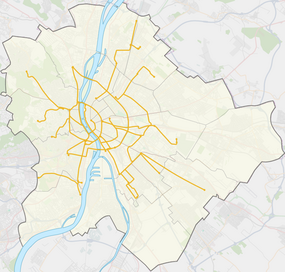| Trams in Budapest | |||||||||||||
|---|---|---|---|---|---|---|---|---|---|---|---|---|---|
 | |||||||||||||
 Line 19 tram in Budapest (2017). | |||||||||||||
| Operation | |||||||||||||
| Locale | Budapest, Hungary | ||||||||||||
| Status | Operational | ||||||||||||
| Routes | 36 (26 main, 9 supplemental, 1 cog-wheel railway)[1] | ||||||||||||
| Owner(s) | BKK | ||||||||||||
| Operator(s) | BKV Zrt. | ||||||||||||
| Infrastructure | |||||||||||||
| Track gauge | 1,435 mm (4 ft 8+1⁄2 in) standard gauge | ||||||||||||
| Propulsion system(s) | Electricity | ||||||||||||
| Stock | 610[2] | ||||||||||||
| Statistics | |||||||||||||
| Route length | 174 km (108 mi)[3] | ||||||||||||
| Stops | 630[3] | ||||||||||||
| 2011 | 393.4 million[4] | ||||||||||||
| |||||||||||||
| |||||||||||||
| |||||||||||||
| |||||||||||||
| Website | https://bkk.hu/en/ Budapesti Közlekedési Központ (BKK) (in English) | ||||||||||||
The tram network of Budapest is part of the mass transit system of Budapest, the capital city of Hungary. Tram lines serve as the second-most important backbone of the transit system after the bus network, carrying almost 100 million more passengers annually than the Budapest Metro.[4] In operation since 1866,[5] the Budapest tram network is among the world's largest tram networks by route length—operating on 174 kilometres (108 mi) of total route[3]—and is the busiest in the world.[6][7]
As of 2023[update], the tram network is made up of 35 regular lines (26 main lines and 9 supplemental lines) and the Budapest Cog-wheel Railway (signed as route 60).[1] The system is operated by Budapesti Közlekedési Zrt. under the supervision of the municipal Budapesti Közlekedési Központ. Since 2016, the system uses the world's longest 9-sectioned articulated tram vehicle, the CAF Urbos 3/9, on route 1.
- ^ a b "Budapesti Közlekedési Központ - Timetables". Budapesti Közlekedési Központ (BKK). Retrieved 2013-10-17.
- ^ "Annual Report 2021" (PDF). BKV Zrt. 2021. p. 18. Retrieved 2023-02-12.
- ^ a b c "Annual Report 2011" (PDF). BKV Zrt. 2011. p. 48. Retrieved 2013-10-06.
- ^ a b "Annual Report 2011" (PDF). BKV Zrt. 2011. p. 4. Retrieved 2013-10-06.
- ^ Cite error: The named reference
history1was invoked but never defined (see the help page). - ^ "Vitézy Dávid: Budapesté a világ legforgalmasabb villamoshálózata". HVG. 15 June 2023. Retrieved 25 December 2023.
- ^ Kéfer, Ádám (15 June 2023). "Budapesté a világ legforgalmasabb villamoshálózata". Index.hu. Retrieved 25 December 2023.
